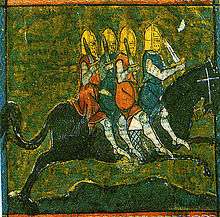Bayard (legend)

Bayard (French: Bayard; Italian: Baiardo; Dutch: (Ros) Beiaard) is a magic bay horse in the legends derived from the chansons de geste, renowned for his spirit, and possessed the supernatural ability to adjust his size to his riders.
Legend
Bayard first appears as the property of Renaud de Montauban (Italian: Rinaldo) in the Old French twelfth century chanson de geste Quatre Fils Aymon. The horse was capable of carrying Rinaldo and his three brothers ("the four sons of Aymon") all at the same time and of understanding human speech. Near the end of the work, Renaud is forced to cede Bayard to Charlemagne who, as punishment for the horse's exploits, has a large stone tied to Bayard's neck and has the horse pushed into the river; Bayard however smashes the stone with his hooves and escapes to live forever more in the woods.[1]
In subsequent chansons de geste, Bayard was said to have been initially won by Renaud's cousin, the magician Maugris, before being given to Renaud.[2]
In Bulfinch's Mythology, Rinaldo's acquisition of Bayard is described as follows: a disguised Maugris (who had previously acquired Bayard) tells Rinaldo that a wild horse under an enchantment roams the woods, and that this horse belonged initially to Amadis of Gaul and can only be won by a knight of Amadis' lineage. Rinaldo eventually subdues the horse by throwing it on the ground, breaking the enchantment.[3]
Bayard also appears in the epic poems on chivalrous subjects by Luigi Pulci, Matteo Maria Boiardo and Ludovico Ariosto.
Bayard by the late 13th century also acquired common usage as a name for any bay-coloured horse (reddish-brown coat with black mane and tail) and lost some of his lustre as a magic heroic horse. "Bayard"became associated in English literature with a clownish, blind and foolish horse.
Chaucer first used Bayard as the name of Troilus' horse in the epic poem "Troilus and Criseyde." That horse, talking while he pranced, admitted that he was bound to be but a horse. Chaucer also used Bayard in the Canterbury Tales (c. 1286) to denote a randy stud in the Reeve's Tale and a blind, foolish horse in The Canon's Yeoman's Tale: "Though ye prolle ay, ye shul it nevere fynde. Ye been as boold as is Bayard the blynde. That blondreth forth and peril casteth noon." ("Though you search afar, you shall never find it; Be you as bold as Bayard the blind, that blunders forth and perceives no peril.)
Local
Outside the town of Dinant in Belgium stands "Bayard rock", a large cleft rock formation that was said to have been split by Bayard's mighty hooves. In the next town down river Namur stands a locally famous statue of the Horse Bayard and the Four Aymon Brothers along the River Meuse. There are plenty of named places in Wallonia linked to the legend of Four Aymon Brothers and Bayard.
The Bayard legend is also celebrated in other towns in Belgium most notably in the Flemish town of Dendermonde, where a large procession is organized every ten years. The rivalry between Dendermonde and Aalst, a city close by, has led to the construction of the Steed Balatum by the inhabitants of Aalst, as a parody on Bayard. Processions are also organized at Mechelen and Ath. There are Bayard statues at Ghent and Grembergen.
Note that a magical horse Blind Byard is part of Lincolnshire folklore at Byard's Leap
References
Notations
- Chanson de Renaud de Montauban
- Orlando innamorato by Matteo Maria Boiardo
- Orlando furioso by Ludovico Ariosto
French
- Hasenohr, Geneviève and Michel Zink, eds. Dictionnaire des lettres françaises: Le Moyen Age. Collection: La Pochothèque. Paris: Fayard, 1992. ISBN 2-253-05662-6
- Les Quatre Fils Aymon ou Renaud de Montauban Presentation, selection and translation in modern French by Micheline de Combarieu du Grès and Jean Subrenat. Paris: Gallimard, 1983. ISBN 2-07-037501-3
Footnotes
- ↑ Les Quatre Fils, 273-4.
- ↑ Hasenohr and Zink, 1257-8.
- ↑ Thomas Bulfinch, Bulfinch's Mythology (Kessinger Publishing, 2004, ISBN 1-4191-1109-4, ISBN 978-1-4191-1109-9), pp.407-8. An online edition of the Bulfinch version can also be found here "Archived copy". Archived from the original on 2008-08-02. Retrieved 2008-08-12.
See also
| Wikimedia Commons has media related to Bayard. |
- Veillantif - Roland/Orlando's horse (also called Brigliadoro)
- Marshal Ney-often used as a nickname
- Ros Beiaard - Flemish folkloristic procession in Dendermonde